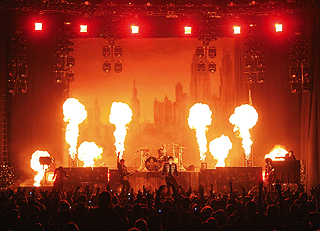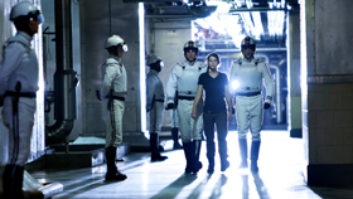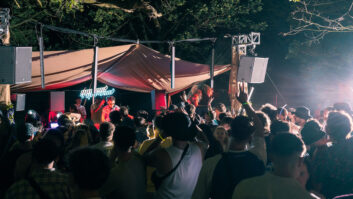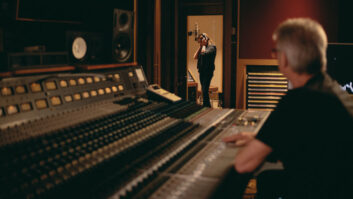
Skyrocketing to Billboard‘s Number 2 slot in its first week of release, The Black Parade from My Chemical Romance has attracted so many fans to the band’s current tour that they have added dates to the U.S. leg. Showcasing material from that album, as well as top hits from previous outings, My Chemical Romance wowed the pumped-up crowd in Oakland, Calif.’s Oracle Arena in mid-March. Or as front-of-house engineer Dave Rupsch says, “If the first half of the show is a large cup of coffee, the second half is 23 shots of espresso ingested through a beer bong.”
The main P.A. system is an L-Acoustics V-DOSC, hanging 12 boxes per side with three dV-DOSCs at the bottom. Six additional V-DOSC cabs and six dV-DOSCs are used for side hangs. “It’s such a smooth-sounding enclosure: crystal high-end and an unbeatable punch on your low-mids,” Rupsch enthuses. “I also love the V-DOSC’s coverage.” For front-fills, Rupsch uses L-Acoustics ARCs or dV-DOSCs. XTA software and crossovers drive the Lab.Gruppen amps.
According to monitor engineer Ivan Laporte, the bandmembers use a combination of in-ears and wedges. “Frank [Iero, guitarist] only uses wedges,” he says. “He didn’t like the feel of the IEM. His mix is pretty simple: kick, snare, toms, guitars and vocals. Mikey [Way, bassist] uses IEMs; he likes very little of himself and more of the rest of the band. Gerard [Way, vocalist] uses IEMs; he likes lots of reverb and chorus on his vocals. Of all the mixes, his is the closest to a well-balanced album mix. Ray [Toro, guitarist] uses IEMs and wedges — mostly guitars, drums and vocals. Bob [Bryar, drummer] uses a Buttkicker and IEMs, with an overall mix in the left ear and a click on the right.”
Laporte mixes on a Yamaha PM5D using all onboard effects and dynamics. For his mixing technique, he relies on a wide stereo image. “Ambience mics play a key role in the performance,” he explains. “The gain structure is pretty even across the board. When you have good-sounding instruments and great musicians, your gig is 50 percent done; you just need to add what they need to be comfortable while performing.”
On the tour’s Midas Heritage 3000 (48 channels), FOH engineer Dave Rupsch installed additional stereo modules to accommodate the band’s 50-channel input list and stereo effects returns. “The preamps on the Heritage are really pleasing to my ear,” Rupsch says of the board. “The Heritage has a reputation of letting the mixer ‘heat up’ the input gain and bring out an unmistakable punch to inputs such as drums, which is 25 channels of my input list. Secondly, the Heritage has a smooth-feeling interface. During my set, I constantly move around the console making adjustments. Every job has its proper tool, and the Heritage 3000 is a beautiful rock ‘n’ roll desk, fitting perfectly into form for this show.”
Rupsch carries quite a selection of outboard gear for this Rat Sound-supplied tour, including BSS Audio 901 II comps chained with Empirical Labs Distressor EL8s for center- and stage-left vocals. “There are a few extreme frequency areas on [lead vocalist Gerard Way’s] voice that can quickly run out of control if not properly combated,” Rupsch explains. “From the console channel, the signal first runs into the 901 where I compress a sharp cut around 500 Hz, 1.6 kHz to 3.15 kHz, and finally on the 8 kHz to 12 kHz. After that, the Distressor gives it a final smoothing before it returns to the channel. The same is done to stage-left [Ray Toro’s vocal].” Rupsch’s effects list comprises Yamaha SPX-990s, a Lexicon PCM91, an Eventide 3000 Ultra-Harmonizer and a TC Electronic D-Two “for fun,” he says.
“My mixing is split into two different styles for this show,” Rupsch continues. “For the first half, the band plays their current record, The Black Parade, from front to back. Songs like ‘Welcome to the Black Parade’ and ‘Disenchanted’ have the most layers, and it’s a challenge to get them to breathe and have the layers nest among each other in these large rooms. I get goosebumps from accurately capturing that and delivering it to an excited crowd.
“The second half goes back to older material, with a four-piece drum kit with a 24-inch kick versus a 26-inch kick [used for the first half]. Guitar parts for these older songs are about as busy as guitars can be, and keeping these blistering fret burners under control in an arena is a challenge. For both sets, I mix Frank’s tone a little darker and Ray Toro’s a bit brighter. I keep my fingers on the mute buttons of the mics that I expect to get knocked over during the show!”





